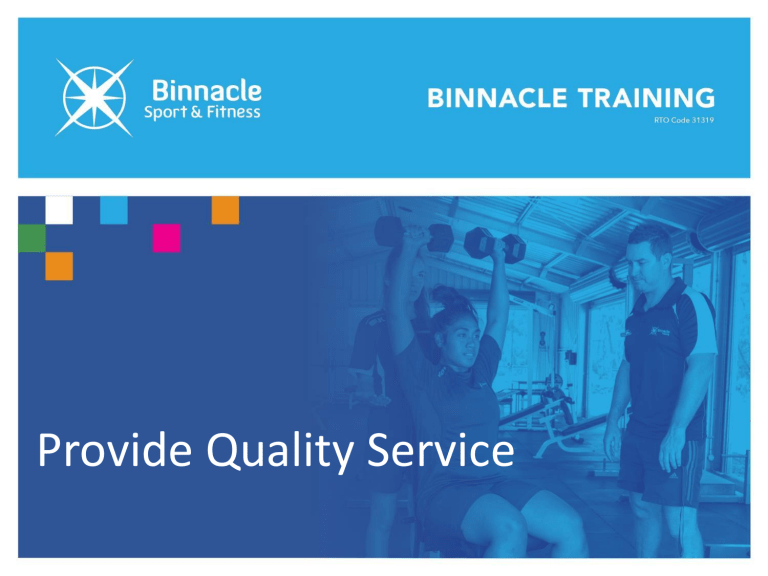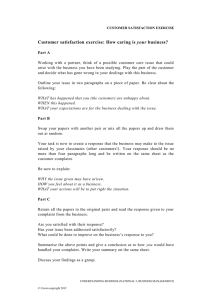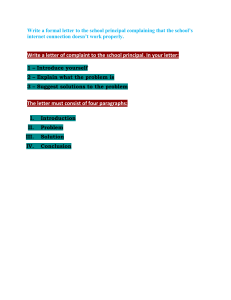
Provide Quality Service Guidelines for Personal and Professional Appearance A gym or sports club is a recreational environment for most people however, for SFR professionals, it is a workplace. Therefore, it should be treated that way, in both actions and appearance. Guidelines for Personal and Professional Appearance PROFESSIONAL GYM ATTIRE – When operating as a paid SFR professional, the dress code should be a polo shirt, sports shorts and adequate foot wear for a gym/training environment (no skate shoes, slip-ons, singlets or training shirts). PERSONAL HYGIENE – Trainers are often required to spend plenty of time in close proximity to their customers. Using mouthwash, brushing teeth, applying deodorant and after shave, perfume or cologne is recommended. GROOMING – Trainers should take pride in their appearance to portray a good image – particularly for a first impression. Guidelines for Personal and Professional Appearance AVOID THE ‘JUST GOT OUT OF BED’ LOOK – SFR professionals have a responsibility to be prepared for early morning sessions. KEEP FIT – Trainers should set an example by staying reasonably fit and keeping active. Expectations of Professionalism From An SFR Professional • TIME MANAGEMENT – Manage appointment – Communicate appointment times and changes to clients • PUNCTUALITY – Arrive to sessions ahead of time. – Be ready to go when the client arrives. • RUN CLIENT-SPECIFIC SESSIONS – Write programs specific to the needs of individuals – Don’t recycle programs or use “cookie cutter” routines – Ensure group programs cater for all participants Expectations of Professionalism From An SFR Professional • RECORD DATA – Log session feedback and reviews – Record session outcomes • MEASURE CLIENT RESULTS – Track client progression – Update programs to ensure continual progression • REMAIN PROFESSIONAL – Communicate in a professional manner – Use politically correct terminology at all times Expectations of Professionalism From An SFR Professional KNOW THE BOUNDARIES – Never make inappropriate comments or advances – Keep all workplace relationships strictly professional PLAY CLOSE ATTENTION TO CLIENTS AT ALL TIME – Avoid all distractions including mobile phones – Give your full attention to participants throughout the session Ethics of an SFR Professional Confidentiality Personal relationships Respecting client rights Discrimination Working relationships Professional development Competence Referring clients Keeping client records Requirements of an SFR Professional Requirement Respecting client rights Definition To promote and protect the dignity, privacy, autonomy and safety of all people whom they come in contact with in their professional practice. Keeping records To keep records and reports clearly and concisely for the information of clients, professional colleagues, legal purposes and to record fitness services. Discrimination To not discriminate on the basis of ethnicity, culture, impairment, language, age, gender, sexual preference, religion, political beliefs or status in society. Working relationships To respect the needs, traditions, practices, and responsibilities of their own and other professions, as well as those that constitute their working environment. Competence To acknowledge the boundaries of their competence (i.e. to provide services and use interventions, for which they are qualified through training and experience). Personal relationships To refrain from entering into personal relationships, which damage the establishment and maintenance of professional trust. Professional development (PD) To maintain their own level of professional competence and strive to improve and update knowledge and skills. Confidentiality Referring clients To safeguard confidential information relating to clients in accordance with privacy laws. To respond to referrals in a timely manner. Provide Quality Customer Service A satisfied customer tells less people about the experience than a dissatisfied customer. It costs more to attract a new customer than it does to keep an existing one. The average organisation never hears from 96% of dissatisfied customers. Of customers who register a complaint, most will do business again if it is resolved quickly and effectively. The Importance of Customer Service Because there is PLENTY of competition. • In many cases there will be several choices for customers (i.e. other gyms, sports facilities and trainers). • In order to win (and keep) that customer, great service should be provided. The Importance of Customer Service • Customer satisfaction is important for maintaining a competitive edge in one of the fastest growing industries (SFR industry). • Loyalty and repeat business are driven by customer satisfaction. • Customer satisfaction has a positive influence on longterm profitability for a sporting organisation, fitness centre or any SFR industry professionals (e.g. coaches, personal trainers). Customer Service Good customer service is defined as: “How customers perceive that an organisation has delighted them, by exceeding their needs”. Achieving customer satisfaction means understanding customer needs and going above and beyond to accommodate them. Quality Service Clientsatisfaction This is crucial to the success of a business and is dependent on clearly understanding requirements. Client feedback Provides a measure of accountability for keeping staff aware of client satisfaction with service Client service This includes enhancing client experience (e.g. by keeping high standards of appearance and cleanliness of facilities) Client-centred approach Place the client at the focus of all work considerations and conduct Poor Customer Service Factors which may lead to poor customer service include: • No service philosophy or standards of service performance. • Poor handling of complaints. • Failure to resolve a complaint to the customer’s satisfaction. • Staff given little or no customer service training. • Staff not empowered to provide excellent customer service. • Complaints are often seen as annoyances, when they can actually be a way to improve. Examples of Good Customer Service Knowing customer needs and expectations Smiling Paraphrasing Eye contact Using appropriate language and speaking clearly Knowing when to refer a customer (e.g. if the task is outside of expertise) Wearing uniform correctly ‘Going the extra mile’ Being fair to customers Well groomed Cleanliness of facilities Delivering on promises Good personal hygiene Recording customer data and measuring results Being punctual Seeking and acting on feedback CALD Clients CALD = Culturally and linguistically diverse clients A Culturally Inclusive Service Aspects that should be identified with CALD clients include: • • • • • Country of origin and cultural background including ethnicity and religion. Level of English proficiency or if there is a need for an interpreter. Religious practices. Dietary practices. Migration experience. Why these factors are important: • Indication of cultural context; choice of interpreter (if needed). • To ensure communication is clear. • Particular times for prayer may be important; religious practices may conflict with planned sessions. • May be cultural/religious restrictions on foods consumed; some foods may have cultural meaning. • Health status can be affected (e.g. client may have been displaced for a long period). A Culturally Inclusive Service Benefits of creating a culturally inclusive environment: • Allows participants to feel like they can be themselves • Participants feel safe, supported and shielded from abuse • All participants feel encouraged to take part in activities Want to know more about CALD clients and their practices? • Conduct your own research to demonstrate your willingness to learn and acceptance of the CALD client • Over time, ask open questions in a non-judgmental or discriminatory way if you have a good relationship with the client Cultural Customs Practiced by CALD Clients Ramadan • The Muslim religious month of fasting during sunlight hours • Can impact scheduling sessions to align with eating times Food Taboos • Social or religious protocols towards eating and eating preferences e.g. vegetarianism • Impacts the provision of nutritional advice Cultural Customs Practiced by CALD Clients Dress Codes and Modesty of Clothing • Some religions require the wearing of clothing that covers certain body parts, or the entire body (e.g. wearing a hijab or burqa) • This can impact taking progress photos and body composition tests Prayer Times • Some religions stipulate that prayer should be conducted at specific times throughout the day • This can impact scheduling sessions Body Language and Communication • Some belief systems may discourage direct eye contact • This can impact how you conduct yourself during sessions and consults Communicating with Clients who have Low English Proficiency Be aware that you must communicate through more than words alone. Be mindful of the following: • Body language/posture • Facial expressions • Tone of voice • Gestures. Communicating with Clients who have Low English Proficiency LITERACY • Use explanatory diagrams as well as text; translated information. SPEECH • Speak slowly and do not shout. LISTENING AND OBSERVATION • Be aware of body language (eye contact). • Try not to finish their sentences. • Be comfortable with silences and long pauses. TIME • Allow a longer than usual time for a reply when asking questions. Communicating with Clients who have Low English Proficiency GENERAL GREETING, FAREWELLING AND CONVERSING • Avoid physical contact • Respect clients personal space and stand at a comfortable distance • Avoid raising your voice and speak politely COMMUNICATING WITH BODY LANGUAGE AND GESTURES • Face towards clients and demonstrate that you’re giving them your attention • Be open and upright (not slumped or closed off) • Communicate with simple gestures where possible (e.g. waving hello/goodbye, pointing, thumbs up etc) Communicating with Clients who have Low English Proficiency APPROPRIATE LANGUAGE SELECTION • Avoid slang or complex terminology • Try to use formal language APPROPRIATE CLOTHING AND PRESENTATION • Communicate the need for appropriate attire from clients (e.g. closed in footwear) by modelling this yourself • Respect clients rights to wear religious clothing items and adjust sessions appropriately to ensure safety Being an Effective Communicator Empathic Listening – “Seek first to understand” • Listening with an intent to understand. • People want to feel like they are being heard and understood. Good communication occurs through different channels • Verbal Communication: what you say. • Non–verbal communication: what you do (gestures, expressions, body language). • Written communication. Tips for listening and questioning • Keep questions open-ended. • Try to avoid answering your own questions. • Wait – do not be afraid of silence as some people need longer to answer a question than others. • Show through your gestures, expression and body language, as well as verbally, that you are genuinely interested in what is being said. Conflict Resolution Let the person have their say. Reflect their concerns. Clarify their concern. Identify the issue. Suggest a solution. Refer an unresolved complaint. Conflict Resolution Method 1. Let the person have their say. 2. Reflect their concerns. 3. Clarify their concern. 4. Identify the issue. 5. Suggest a solution. 6. Refer an unresolved complaint. Handling Customer Complaints Provides a measure of accountability for keeping staff aware of customer satisfaction. Used for continuous improvement. Gives the customer an opportunity to express their opinion. Allows the trainer to improve their service. Customer Feedback Form CLIENT FEEDBACK REPORT FORM CLIENT DETAILS Name: Position: Signature: Date: Time: Feedback Received: Customer Requirements: ACTION TAKEN COMMUNICATION TECHNIQUES TO CLIENT (E.G. FOR DELAYS/PROBLEMS) Verbal Written Electronic Other (e.g. audio/video) Please specify (e.g. hand written; email; taped): Documentation to support feedback attached (please tick) RECOMMENDED COURSE OF ACTION FOR ORGANISATION AND/OR CLIENT Handling Complaints 1. DEAL WITH THE FEELINGS • Acknowledge how the customer feels. • Remain calm (at least look like you are calm). • Do not argue – listen and reflect. 2. DEAL WITH THE PROBLEM • • • • • • • Clarify the complaint. Find out what the customer wants and reflect this. Be aware of your limitations (know when to refer the complaint). Suggest alternatives, but only those that can be delivered. Agree on a course of action. Refer the complaint (if needed). Thank the customer for bringing the complaint to the attention of staff. 3. FOLLOW UP • Check with the person that the complaint was referred to and follow up with the customer, if appropriate. Referring Customer Complaints If a complaint is beyond the responsibility of a particular staff member, it must be referred to a supervisor. However, remember to: • Take responsibility. • Follow up on the complaint. • Record the complaint. Clients at risk of not achieving a Healthy Lifestyle People who are unemployed. People with a disability, including mental illness. People affected by alcohol and/or substance abuse. Frail, elderly people. People from remote communities. Basic Counselling Skills Needed to facilitate various goals and provide basic support when a customer: • Is disappointed with their assessment results. • Is having second thoughts about their training program. • Is having a personal issue (be aware of professional boundaries – refer if needed). • Has body image issues (be aware of professional boundaries – refer if needed). Recognise the limitations of counselling skills: • Know when to refer (e.g. to professional counselling organisations): • Relationship issues. • Depression. • Underweight. • Low self-esteem. Professional Counselling Resources LifeLine (13 11 14): • Lifeline is a non-profit organisation that provides free, 24-hour telephone crisis support service in Australia. Volunteer crisis supporters provide suicide prevention services, mental health support and emotional assistance Psychologists: • A psychologist is a professional who practices psychology and studies normal and abnormal mental states, perceptual, cognitive, emotional, and social processes and behaviour, and can provide counselling to individuals. Relationships Australia: • Relationships Australia works in a variety of ways to support respectful relationships across Australia.

